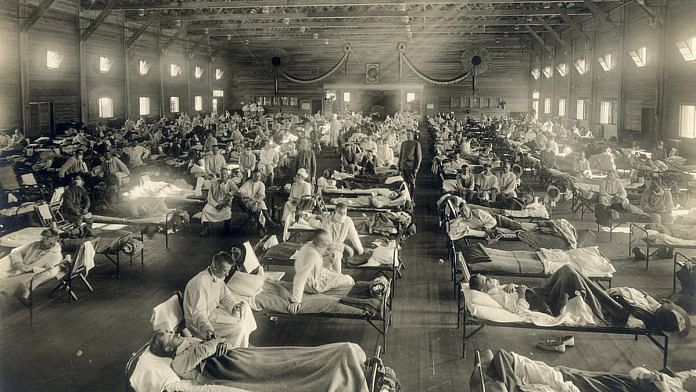New Delhi: The World Health Organization (WHO) has declared the novel coronavirus or COVID-19 outbreak a global pandemic. With more than 4,000 deaths and over 118,000 positive cases, the virus has now spread to 114 countries.
The outbreak comes nearly a century after the Spanish influenza pandemic of 1918, which had claimed somewhere between 50 and 100 million lives globally and 10 to 20 million in India alone.
Referred to as “The Bombay Influenza” or “The Bombay Fever”, the flu, according to a report, had arrived in India via the ports of Bombay in May 1918. The report quotes J.A. Turner, then health officer of the city, who said the epidemic “came to Bombay like a thief in the night”.
Seven police sepoys at the Bombay docks were among the first to be admitted to the police hospital with a “non-malaria fever”, the report notes. Soon, employees of a shipping firm, the Bombay Port Trust, the Hong Kong and Shanghai Bank, the telegraph office, the mint and the Rachen Sassoon Mills also fell ill.
The first wave of the infection — that began as an epidemic — seemed to have only affected the elderly and children, the report further notes.
Researcher David Arnold, in his paper titled ‘Death and the Modern Empire: The 1918-19 Influenza Epidemic in India’, has written that the second wave was more fatal, killing adults between the ages of 20 and 40.
“In one day alone, 6 October 1918, there were 768 registered deaths from influenza in Bombay city, more deaths than at the height of the plague epidemic in the 1890s and 1900s,” Arnold wrote.
The disease later swept across India, spreading to Punjab and the United Provinces (now Uttar Pradesh).
‘Strangest time’
Describing the devastating effects of the illness, several reports of the time also noted how the Ganga river had swelled with bodies.
The disease had claimed 10 to 25 million lives in the country — almost a fifth of the global death toll and 4 per cent of the population, as recorded in the decennial census of 1911.
A deep dive into the “Spanish flu of 1918 [that] changed India” quotes poet Suryakant Tripathi who had written about the tragedy.
“This was the strangest time in my life…My family disappeared in the blink of an eye. All our sharecroppers and labourers died, the four who worked for my cousin, as well as the two who worked for me,” wrote Tripathi.
Mahatma Gandhi, who was recovering from an acute dysentery at the time, had also alluded to the pandemic in a letter he wrote to someone addressed as ‘Gangabehn’.
The letter read: “Our ancestors could build such tough bodies in the past. But today we are reduced to a state of miserable weakness and are easily infected by noxious germs moving about in the air. There is one and only one really effective way by which we can save ourselves from them even in our present broken state of health.”
Also read: What the coronavirus end game will look like







Leftist and commie historians completely hid these kind of events out of our history books. Sad!
Even after 102 years a single non living cell is still the greatest threat to humanity. Hopefully in a few more years we will overcome all such viruses with generic vaccines and cure…have faith in science.
Have faith in people like Bill Gates.
WE must consider ourselves lucky that this 1918 epidemic spared the lives of some of our tallest political leaders, who were all alive at the time.